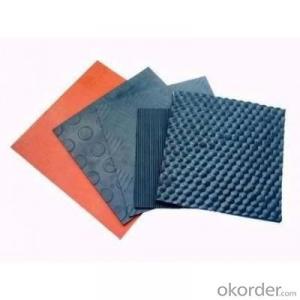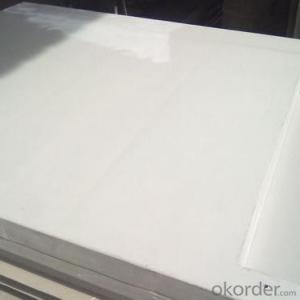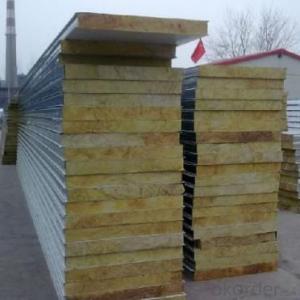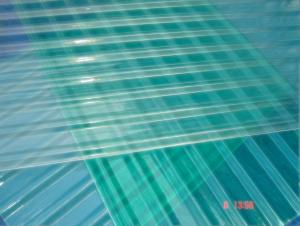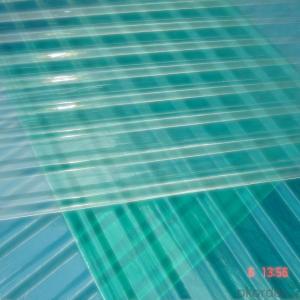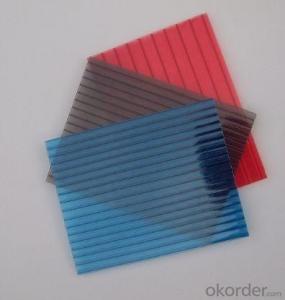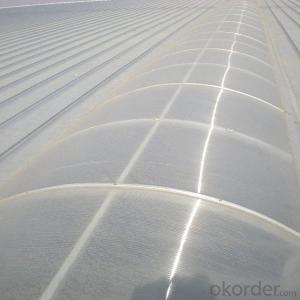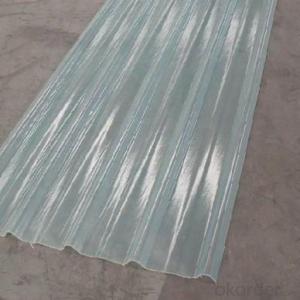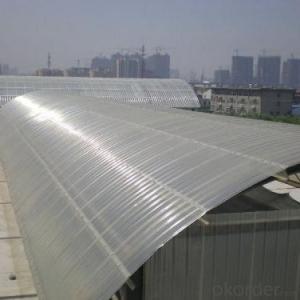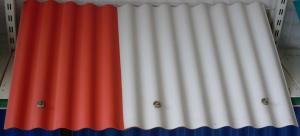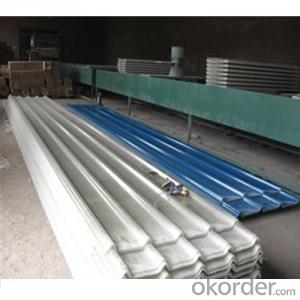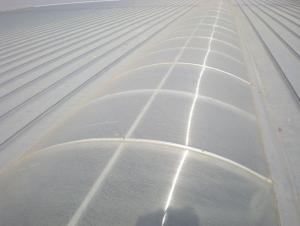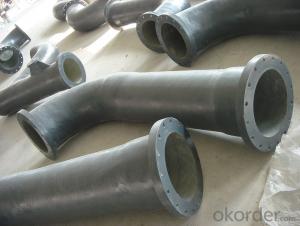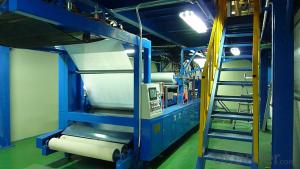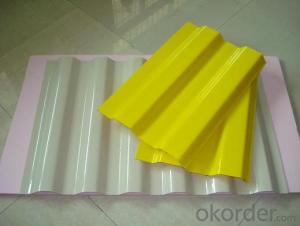Frp Roofing Sheet Corrugated Fiberglass Plastic Roofing
- Loading Port:
- Tianjin
- Payment Terms:
- TT OR LC
- Min Order Qty:
- 500 m
- Supply Capability:
- 60000 m/month
OKorder Service Pledge
OKorder Financial Service
You Might Also Like
Item specifice
PRODUCT DESCRIPTION
Equipment is FRP continuous molding machine, unit mix of resin, fiber Wall to Wall thickness control, process regulation, curing, cutting, cleaning consisting of several parts. The production capacity can reach 2,500 meters. The accuracy of the equipment reached the advanced level, while the advanced production technology to ensure product quality and stability.
FRP flooring panel is a big size profile which is made by pultrusion technology and in holistic shape, it could
form a continuours close plane by unique self-lock structure,which could be used as load structures in various
corrosion environments and could replace wood plate, aluminum plate or steel plate etc.
FEATURES
1.Light transmission rate of 80%
2.Anti-aging
3.good corrosion resistance
4.excellent toughness
5.used in -60°c to 100 °c
6.Thickness:0.8-2.5mm
7.length:Customized
8.Excellent water resistance
9.Impact resistance
SPECIFICATIONS
| Name: | Frp Roofing Sheet Corrugated Fiberglass Plastic Roofing |
| Material: | Protective film, Unsaturated resin polyester, Fiberglass |
| Weight: | 1800g/2400g/2750g/3050g Square meter |
| Thickness: | 0.8~3.0mm |
| Length: | Customized |
| Temp: | used in -40°c to 140 °c |
| OEM: | Welcomed |
| Color: | Clear/Blue |
PICTURES


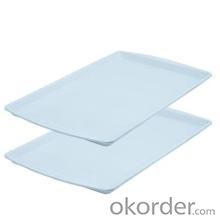
- Q:Do FRP roofing panels require any specific type of underlayment?
- Yes, FRP roofing panels typically require a specific type of underlayment. It is recommended to use a moisture-resistant and non-combustible underlayment, such as a high-density polyethylene (HDPE) or a fiberglass mat, to ensure proper installation and to enhance the longevity of the roofing system.
- Q:Are FRP roofing panels suitable for hospitals or healthcare facilities?
- FRP roofing panels are a great option for hospitals or healthcare facilities due to their many advantages. Firstly, they are incredibly durable and can withstand corrosion, UV rays, and chemicals, which is essential for maintaining a sanitary environment. They can also handle frequent cleaning and sterilization procedures without any damage. Secondly, FRP panels are lightweight yet strong, making them easy to install and reducing the strain on the building structure. They can withstand extreme weather conditions and natural disasters, ensuring a secure and reliable roofing solution. In addition, FRP panels provide excellent thermal insulation, helping to regulate the temperature and reduce energy consumption. This creates a comfortable and energy-efficient environment for patients' well-being and recovery. Furthermore, architects and designers have the freedom to choose from a variety of colors and finishes for FRP panels, allowing them to match the aesthetic requirements of the healthcare facility. The panels can also be customized to include skylights or windows, providing optimal natural lighting and ventilation. Lastly, FRP panels require minimal maintenance, resulting in lower costs associated with roof upkeep. They are resistant to mold, mildew, and pests, ensuring a clean and healthy environment for hospitals or healthcare facilities. Overall, FRP roofing panels offer numerous advantages, including durability, lightweight yet strong composition, thermal insulation, customization options, and low maintenance requirements. These qualities make them an excellent choice for hospitals or healthcare facilities, providing a safe, hygienic, and comfortable roofing solution.
- Q:Can FRP roofing panels be recycled at the end of their lifespan?
- Yes, FRP (Fiber Reinforced Plastic) roofing panels can be recycled at the end of their lifespan. FRP is a composite material made up of a plastic resin reinforced with fibers, usually fiberglass. The recyclability of FRP roofing panels depends on the specific recycling facilities available in the region. The recycling process for FRP panels involves grinding them into small pieces or shredding them to separate the plastic resin from the fibers. The separated components can then be reused or repurposed for various applications. The plastic resin can be melted down and reused in the manufacturing of new plastic products, while the fibers can be used in the production of reinforcements for concrete or other composite materials. It is worth noting that not all recycling facilities are equipped to handle FRP panels due to their composite nature and the challenges associated with separating the plastic resin from the fibers. However, as the demand for sustainable practices and the recycling of composite materials increases, more specialized recycling facilities are emerging to handle FRP and other composite materials. To ensure the proper disposal and recycling of FRP roofing panels, it is recommended to contact local recycling facilities or waste management companies to inquire about their capabilities and procedures for recycling FRP. Additionally, manufacturers and suppliers of FRP roofing panels may have specific recycling programs or partnerships in place to facilitate the recycling process.
- Q:Do FRP roofing panels have a warranty?
- FRP roofing panels are generally accompanied by a warranty, which can differ depending on the manufacturer and product. Reputable FRP roofing panel manufacturers typically provide warranties that safeguard against any material or workmanship defects. These warranties generally last for a specific period, like 10, 15, or 20 years. Before purchasing FRP roofing panels, it is crucial to thoroughly read and comprehend the warranty in order to comprehend the scope of coverage, exclusions, and any applicable conditions or limitations.
- Q:Are FRP roofing panels resistant to impact?
- FRP roofing panels are generally resistant to impact, thanks to their durability and strength. They can endure various types of impact without breaking or cracking. The reinforced fiberglass in the panels adds extra strength, allowing them to handle heavy loads like hail or falling debris. In industrial and commercial settings, such as warehouses, factories, and agricultural buildings, FRP panels are commonly used because of their crucial impact resistance. However, it's worth noting that the level of impact resistance can vary depending on the specific brand and quality of the panels. To ensure the panels meet the desired impact resistance requirements for a particular project, it is always advisable to consult with the manufacturer or supplier.
- Q:Can FRP roofing panels be used for green roofs with vegetation or gardens?
- Yes, FRP (Fiberglass Reinforced Plastic) roofing panels can be used for green roofs with vegetation or gardens. FRP roofing panels are lightweight, durable, and have excellent weather resistance, making them suitable for supporting the weight of plants, soil, and water on a green roof. The panels are available in various thicknesses and can be customized to accommodate the specific requirements of a green roof system. To create a green roof with FRP panels, a layer of waterproofing membrane is first installed on the panels to prevent water leakage. Next, a drainage layer is added to allow excess water to drain away. A filter fabric is then placed on top to prevent soil from clogging the drainage system. After the basic layers are in place, a growing medium or soil mixture is added to provide a suitable environment for vegetation to thrive. Finally, the desired plants, grasses, or even small gardens can be planted on the green roof. It is important to note that proper planning and design are crucial when using FRP roofing panels for green roofs. Factors such as structural support, weight distribution, and drainage must be considered to ensure the longevity and functionality of the green roof system. Consulting with professionals experienced in green roof installation is recommended to ensure a successful project.
- Q:Can FRP roofing panels be installed on flat roofs?
- Yes, FRP (Fiberglass Reinforced Plastic) roofing panels can be installed on flat roofs. FRP panels are lightweight and versatile, making them suitable for various roofing applications, including flat roofs. These panels are designed to provide excellent resistance to weathering and UV radiation, ensuring durability and longevity. Additionally, FRP roofing panels can be easily installed on flat roofs using adhesive or mechanical fasteners, depending on the specific requirements of the roof. Overall, FRP roofing panels offer a cost-effective and efficient solution for flat roof installations.
- Q:Do FRP roofing panels require special installation techniques?
- Yes, FRP roofing panels do require special installation techniques. Due to their unique composition and properties, FRP panels need to be installed carefully and precisely. This typically involves using specific tools, adhesives, and fasteners designed specifically for FRP materials. It is important to follow the manufacturer's instructions and guidelines to ensure the panels are properly installed for optimal performance and longevity.
- Q:Are FRP roofing panels resistant to cracking or splitting from seismic activity?
- FRP (Fiberglass Reinforced Plastic) roofing panels are known for their durability and strength, but they are not specifically designed to be resistant to cracking or splitting from seismic activity. While FRP panels are capable of withstanding certain levels of stress and impact, they may not have the structural integrity to withstand the intense vibrations and movements caused by seismic activity. During an earthquake or other seismic events, buildings and structures experience intense shaking and ground movements. These forces can exert significant stress on the roofing system, including the panels. In some cases, the movement and vibrations can cause cracks or splits to form in the FRP roofing panels. To ensure the safety and integrity of a building's roofing system during seismic activity, it is recommended to use materials specifically engineered for seismic resistance. These materials often include flexible and resilient components that can absorb and dissipate the energy generated during an earthquake, minimizing the risk of cracking or splitting. Therefore, while FRP roofing panels may be strong and durable, it is essential to consider the seismic activity of the area before using them as the primary roofing material. Consulting with a structural engineer or a roofing professional who specializes in seismic-resistant roofing systems is crucial to ensure the safety and longevity of the roof in high seismic areas.
- Q:Can FRP roofing panels be used in residential buildings?
- Yes, FRP (Fiberglass Reinforced Plastic) roofing panels can be used in residential buildings. FRP roofing panels offer several advantages such as durability, longevity, and resistance to corrosion, which make them suitable for residential applications. They are lightweight, easy to install, and require minimal maintenance. FRP roofing panels also provide excellent insulation properties and can help reduce energy costs. Additionally, they are available in a variety of colors and designs, allowing homeowners to choose a style that matches their preferences. However, it is important to consult with a professional or roofing expert to ensure that FRP roofing panels are appropriate for the specific residential building and its unique requirements.
1. Manufacturer Overview |
|
|---|---|
| Location | |
| Year Established | |
| Annual Output Value | |
| Main Markets | |
| Company Certifications | |
2. Manufacturer Certificates |
|
|---|---|
| a) Certification Name | |
| Range | |
| Reference | |
| Validity Period | |
3. Manufacturer Capability |
|
|---|---|
| a)Trade Capacity | |
| Nearest Port | |
| Export Percentage | |
| No.of Employees in Trade Department | |
| Language Spoken: | |
| b)Factory Information | |
| Factory Size: | |
| No. of Production Lines | |
| Contract Manufacturing | |
| Product Price Range | |
Send your message to us
Frp Roofing Sheet Corrugated Fiberglass Plastic Roofing
- Loading Port:
- Tianjin
- Payment Terms:
- TT OR LC
- Min Order Qty:
- 500 m
- Supply Capability:
- 60000 m/month
OKorder Service Pledge
OKorder Financial Service
Similar products
New products
Hot products
Hot Searches
Related keywords
